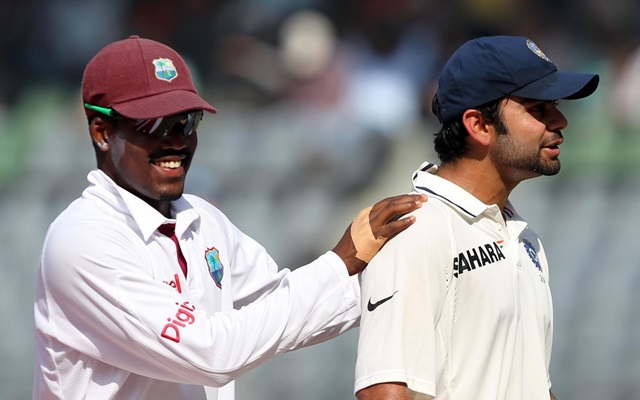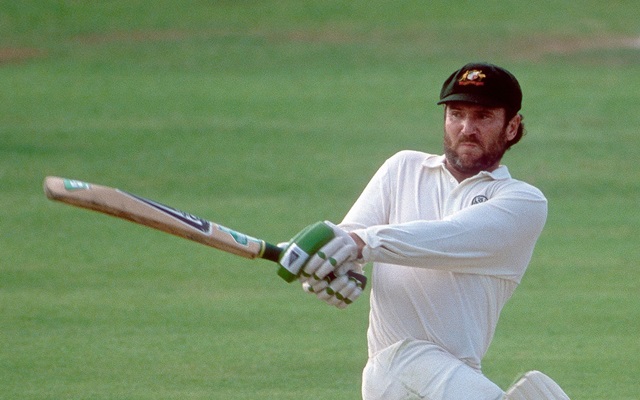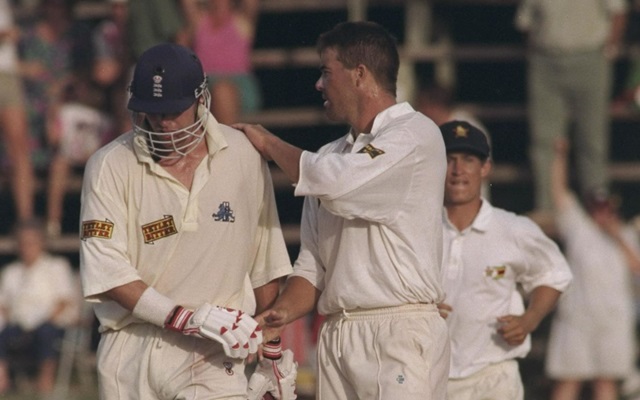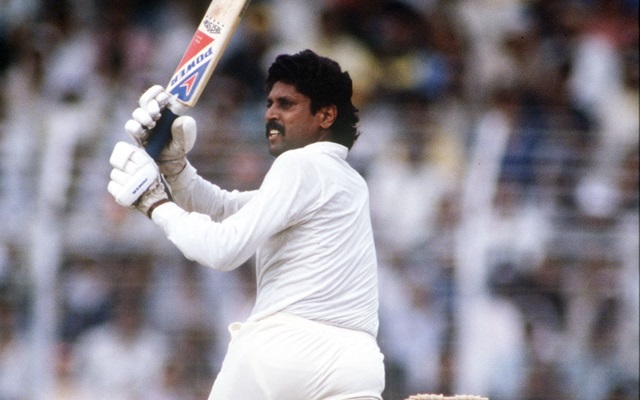Instances when both teams scored same but the match was not a Tie in International Cricket
There are a few instances where both the teams in a game scored the same amount of runs and result was different from a Tie.
2 Min Read


India vs West Indies, 2011 Mumbai Test. (Photo by Santosh Harhare/Hindustan Times via Getty Images)

The invent of the Twenty20 format brought forward a new scenario of deciding the winner through bowl out and Super Over in case of a Tie in scores. There a lot of cases due to the DLS method where both the teams scored the same runs and yet one of them was the winner.
However, in International Cricket, there are a few instances where both the teams in a game scored the same amount of runs and result was different from a Tie despite no usage of rain-rule methods or Tie-breakers post the completion of the match.
Here we look at the occasions where both teams posted the same amount of runs in an International match but the result was not a Tie:
4. Pakistan vs Australia, 1988 Lahore ODI

Australia were expected to feature in three ODIs and three Test matches during the 1988-89 tour of Pakistan. The first ODI was scheduled between 2nd and 3rd Tests while the last two ODIs on consecutive days to conclude the tour.
Pakistan won the first Test by innings margin while the following two games ended in a draw. The first ODI slated to be played in Gujranwala but was abandoned due to floods. The remaining ODIs were scheduled in Karachi and Hyderabad on October 14 and 15 respectively.
But political tensions grew in Pakistan especially in Karachi due to general elections of mid-November. The game in Karachi was cancelled due to curfew while the Hyderabad ODI was moved to Lahore’s Gaddafi Stadium where the last match of Test series was played.
Australia posted 229/8 in the limited 45 overs after losing the toss. Geoff Marsh anchored the innings with an 89-run knock that lasted nearly three hours. Opener Muddasar Nazar was runout scoring 76 which gave the platform for Pakistan in the chase. Saleem Malik (44 off 43) and Ijaz Ahmed (39 off 36) played crucial knocks to ease the pressure of required run-rate.
Tony Dodemaide bowled the last over when Pakistan needed only two runs. Saleem Yousuf picked up a single on the first ball to level the scores before Dodemaide bowled three consecutive dot balls to Wasim Akram who holed out on the penultimate delivery to silly mid-off.
The new batsman Abdul Qadir survived an LBW appeal on the last ball but couldn’t get the required one run. Pakistan also finished with 229/7 in the 45 overs but won the game on losing fewer wickets. If Qadir was given out LBW, count-back on scores would have been required to determine the winner.
3. Zimbabwe vs England, 1996 Bulawayo Test

England toured Zimbabwe for the first time in the 1996-97 season for their first-ever against the Zimbabweans. The two sides were set to clash in two Test matches and a 3-match ODI series. This was also marked to be the first bilateral assignment between England and Zimbabwe.
The tour began with an ODI in Bulawayo which the hosts won by two wickets after bowling England out for 152 only. The confident Zimbabwe team then faced the English team in the first Test at the same venue.
A century from Andy Flower (112) and skipper Alistair Campbell’s 84-run knock helped Zimbabwe to post 376 after electing to bat first. Nasser Hussain (113) and John Crawley (112) struck hundreds as England narrowed the deficit below 50 with six wickets in hand.
But Hussain got out at the score of 328 after a 148-run partnership for 5th wicket leading to a collapse. England eventually bowled out for 406 losing last six wickets for 78 runs thanks to a 5-wicket haul of Paul Strang. By end of 4th day, the home side were five wickets for 107 with a lead of only 77 runs.
Andy Waller (50) and Guy Whittall (58) scored fifties to ensure they went past the 200-run mark. They were bowled out for 234 a little before Tea interval and set England a target of 205 from 37 overs.
Opener Nick Knight and wicketkeeper-batsman Alex Stewart (75 off 76) added 137 in only 115 minutes leaving another 51 runs to get from only eight overs. Zimbabwe tried to bowl wide lines to keep England away from scoring.
The on-field umpires couldn’t do much about it except for calling a couple of wides. But the visitors never bogged down despite losing wickets and needed 13 runs from the last over to be bowled by Heath Streak with 5 wickets in hand.
The first two balls yielded singles while Knight smashed a huge six over square-leg but another two singles left them to chase three runs on the final delivery. Knight drove the last ball towards off-side which was fielded brilliantly at the boundary by Stuart Carlisle.
The duo of Nick Knight and Darren Gough completed two runs and set for an improbable third run. Knight was run out on 96 as the duo didn’t cross by the time the Andy Flower dislodged bails at keeper’s end. Thus, the game ended in a draw with both the teams scoring the same number of runs in the whole game. It was the first-ever match in Test history to end in a draw with the scores level and which has been replicated only once since then.
2. India vs Pakistan, 1987 Hyderabad ODI

Pakistan were enjoying their success in the 1987 tour of India by the time they came to Hyderabad for an ODI. The visitors won the 3-match Test series with a 1-0 margin and were leading the 6-match ODI series 2-0. Hence, the Hyderabad ODI was a crucial one for India but were four down for 95 after losing the toss.
Kris Srikkanth retired hurt early on after suffering a blow on left eyebrow. At this position, the Indian all-rounders Ravi Shastri and Kapil Dev ensured the home team got a decent total on the board.
The then Indian skipper, Kapil, smashed 59 from 52 balls with seven boundaries while Shastri remained unbeaten on 69 off 72. The duo added 112 in only 15.4 overs as India ended up with 212/6 in the restricted 44 overs. Pakistan were cruising in the chase as they reached 187/3 by end of 40th over and needed only 26 more runs from 24 balls. At this stage, Saleem Malik, who scored 84 from only 89 balls, was dismissed by the off-spinner Gopal Sharma.
The equation came down to 7 runs needed from the last over which was to be bowled by the Indian Captain. The first two balls yielded three runs while Wasim Akram was runout on the 3rd ball. A single on the 5th ball gave the strike to Abdul Qadir who needed to get two runs on the final ball. He played the ball towards the square-leg and began to run for a non-existent second run. The local boy Mohammad Azharuddin ensured Qadir was runout with his accurate throw to the wicketkeeper.
Pakistan finished with 212/7 and game ended in a Tie but the rules at that time handed the victory to India on the basis of losing fewer wickets.
The runout of Qadir was Pakistan’s 7th wicket and ended up hurting them big time as the rules of the series considered the countback to scores of both teams at the end of 25th over if both the runs and wickets were same at the end. India were struggling at 81/3 at halfway stage while Pakistan were 101/2 and could have claimed a win if not for Qadir’s runout.
The drama in the game extended after the completion of the game as Pakistan claimed that India had only three fielders inside the 30-yard circle. However, the umpire Vikram Raju said he counted 4 fielders inside the circle and ruled out Pakistan’s allegations.
The square-leg umpire SK Ghosh went on to claim that the Azharuddin also came into the circle by the time Kapil bowled the last ball. Pakistan went on to win the ODI series by 5-1 margin and the Hyderabad ODI was Pakistan’s only defeat to India on this tour.
1. India vs West Indies, 2011 Mumbai Test

India led the 3-match home Test series against West Indies by 2-0 margin after victories in Delhi and Kolkata respectively. The series was set for a conclusion in Mumbai where India aimed a whitewash. But the visitors came up with an impressive batting effort after winning the toss.
Darren Bravo smashed 17 fours during his 166-run knock while the five remaining batters in the top six scored over 60 runs. At one stage, the Caribbean team were 474/3 in 150 overs but bundled out for 590 on 3rd day morning.
India’s top-order put up a similar show as four of their top six scored fifties while another two got 30s. But none of them converting them saw them reduced to 331/6 by day 4 morning. Sachin Tendulkar’s hopes on his 100th International hundred evaporated as he was dismissed for 94.
But Ravi Ashwin smashed his maiden ton batting alongside Virat Kohli and the tail as India ended up with 482 and brought down the deficit to 108. Ashwin, who took a 5-fer in first innings, ran through the WI batting in the 2nd essay with Pragyan Ojha.
West Indies, resuming the final day on 81/2, bowled out for just 134 runs as Ojha and Ashwin took four wickets apiece in the morning session. India had a target of 243 infront of them to chase in 64 overs. The target wasn’t as easy as it looked due to the Wankhede track that began to turn and doing mischievous things. Virender Sehwag, in his usual way, smashed 60 from only 65 balls as India reached 101/2 by 19.1 at the point of his dismissal.
In the next five overs, India lost both their stalwarts Rahul Dravid and Sachin Tendulkar and were four wickets down for 113. As the required rate wasn’t crucial yet, Virat Kohli played a crucial knock without rushing things. He scored 63 from 114 balls before getting out to Devendra Bisho at the score of 224/7 in the 60th over. India still needed 19 runs from 29 balls with Ashwin being their last recognized batsman. Ishant Sharma struck a boundary on the very first ball he faced which eased Ashwin’s job.
The pacer was eventually dismissed in 63rd over leaving India to scored four runs from seven balls. Varun Aaron took a single on the last ball and retained the strike.
Fidel Edwards, who bowled the last over, delivered three successive dot balls before a misfield from Marlon Samuels at mid-off allowed Ashwin to get back the strike. The off-spinner tried to work the penultimate delivery towards on-side but it deflected off the bat and hit his pads.
It ruled out the chance for a West Indian victory but left India to scamper two runs on the last delivery in a tight field placement. Ashwin cross-batted the final ball down the ground and easily completed a single. But he was slow in starting of the first run and turning for the 2nd run resulting his runout at keeper’s end.
Thus, India fell one short of a whitewash as the game ended in a draw with scores-level; the last of the two such instances in the history of Test cricket.
Download Our App